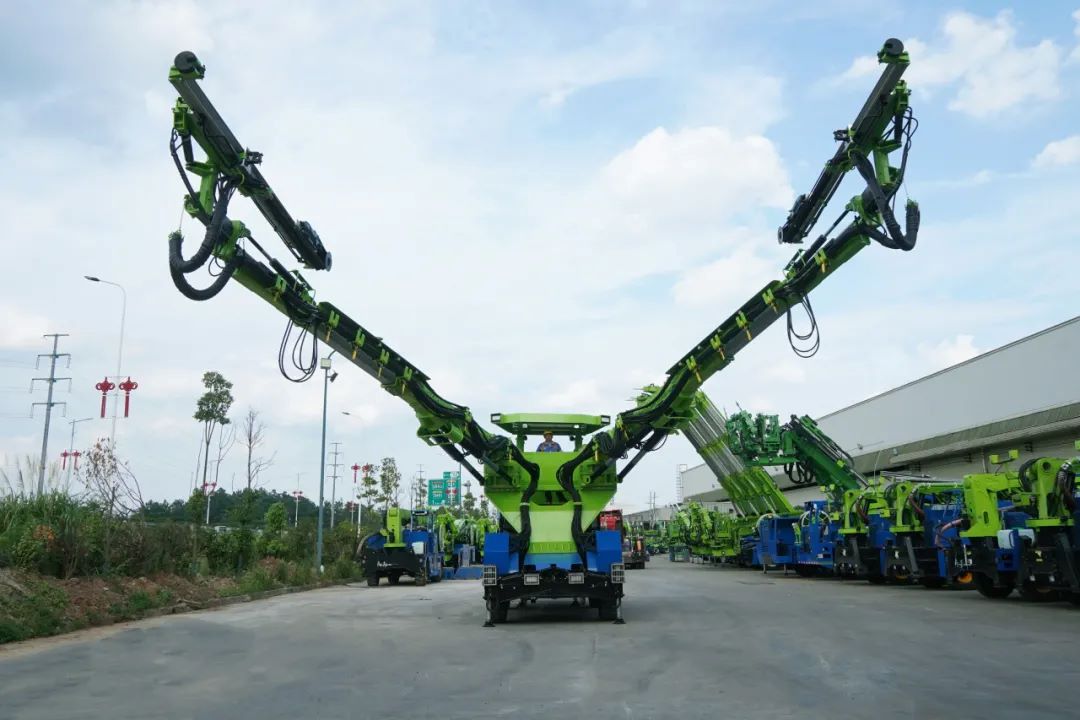A drilling jumbo, as a core piece of equipment in drill-and-blast construction, is renowned for its high-efficiency and precise deep-hole drilling capabilities. It is widely used in both underground and open-pit projects requiring blasting excavation, and performs exceptionally well in hard rock environments. Its applications can be further detailed according to engineering types as follows:

I. Tunnel and Underground Cavern Engineering
Tunnels and underground caverns represent the most central application fields for drilling jumbos, especially in drill-and-blast construction of hard rock (rock firmness coefficient f ≥ 6) or medium-hard rock tunnels, where precise drilling of blast holes is essential for shaping the cross-section.
1. Railway/Highway Tunnels
For long and large tunnels such as the Sichuan–Tibet Railway or the Qinling Zhongnanshan Tunnel (length > 2000 m, cross-section > 50 m²), triple- or quadruple-boom drilling jumbos are often used. These enable coordinated multi-boom operations to drill parallel or fan-shaped blast holes 3–5 m deep at the tunnel face, controlling overbreak/underbreak to within 10 cm and ensuring profile accuracy.
2. Metro Tunnels
Urban metro section tunnels (mostly circular or horseshoe-shaped) require strict vibration and settlement control due to sensitive surrounding environments. Drilling jumbos equipped with intelligent hole layout systems (e.g., full-computer control) can optimize hole density and depth, minimizing blasting impacts on nearby structures.
3. Under-river/Undersea Tunnels
For projects like the Hong Kong–Zhuhai–Macao Bridge subsea tunnel (partial sections using drill-and-blast), drilling jumbos can adapt to high-pressure, high-humidity conditions with corrosion-resistant designs and sealing systems to drill blast holes in underwater rock strata.
II. Mining Operations
In underground mine development and stoping, drilling jumbos are key to achieving large-scale, safe blasting—particularly in hard rock mines (e.g., metal and non-metal mines).
1. Underground Development Headings
Main haulage drifts, ore passes, and ventilation tunnels require drilling 2–4 m deep blast holes. Crawler-mounted or rail-wheel drilling jumbos (for mine tracks or uneven surfaces) can move flexibly, and single- or double-boom models meet the drilling needs of medium to small sections (10–30 m²), replacing traditional pneumatic hand-held drills and improving efficiency by 3–5 times.
2. Stope Blasting
In mining methods like sublevel stoping or sublevel caving in metal mines (e.g., copper, iron), drilling jumbos drill fan-shaped deep holes 5–15 m deep in stope roofs or walls. Precise control of hole direction and angle ensures uniform ore fragmentation and efficient recovery. For instance, at Dexing Copper Mine in Jiangxi, a double-boom jumbo can drill 80–100 deep holes in a single shift, supporting production of tens of thousands of tonnes of ore per day.
III. Hydropower and Energy Underground Works
Underground caverns in the hydropower and energy sectors (e.g., powerhouse caverns, water diversion tunnels, storage caverns) often require large cross-sections and high dimensional accuracy, which drilling jumbos can meet with their automation and precision.
1. Hydropower Station Caverns
Water diversion tunnels (up to several tens of kilometers long), underground powerhouses (cross-section area > 1000 m²), and tailrace tunnels often involve drilling blast holes in hard granite or basalt. For example, in the Baihetan Hydropower Station underground powerhouse, triple-boom jumbos drilled 45–60 mm diameter holes 4–6 m deep, using pre-split and smooth blasting to control the cavern outline, ensuring a tight fit between concrete lining and surrounding rock.
2. Underground Energy Storage Caverns
Pumped-storage underground reservoirs and oil/gas storage caverns demand excavation precision with overbreak/underbreak ≤ 5 cm. Using laser positioning and automatic hole layout systems, drilling jumbos ensure blast hole angle deviations of less than 1°, providing the foundation for lining or seepage prevention works.
IV. Transportation and Municipal Underground Projects
Beyond traditional tunnels, urban underground utility corridors and pedestrian underpasses also benefit from drilling jumbos when drill-and-blast is used, offering high efficiency with low disturbance.
1. Urban Utility Corridors
For corridors through rock (typically rectangular, 3–6 m wide), it is crucial to minimize impacts on roads and buildings above. Drilling jumbos can optimize blast parameters (e.g., small-diameter holes, decoupled charging) to control single-delay charges, achieving “micro-vibration blasting.”
2. Underground Passageways and Civil Defense Works
For small-section projects (5–15 m²) like underpasses or civil defense shelters, single-boom jumbos work well in confined spaces to drill 2–3 m deep blast holes, balancing efficiency and safety.
V. Special Engineering Scenarios
1. Defense and Military Projects
Underground command centers, ammunition depots, and other defense structures often require construction in highly concealed, geologically complex areas (e.g., fault zones). Modular jumbos (e.g., with foldable booms) can operate in restricted spaces and may feature dust-proof and explosion-proof systems for specialized conditions.
2. Geological Hazard Mitigation
In rockfall removal or slope-stabilizing pile construction in mountainous areas, drilling jumbos can drill blast holes on steep slopes or unstable rock masses. Controlled blasting removes hazardous rock while minimizing ecological impact.
A drilling jumbo is the core rock-breaking and excavation equipment in drill-and-blast construction. Its application scenarios span transportation, mining, hydropower, and municipal underground works, providing a crucial guarantee for safe, efficient, and precise excavation in hard rock environments.





